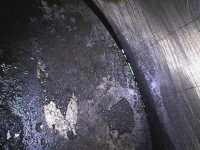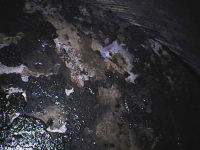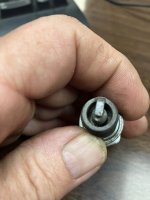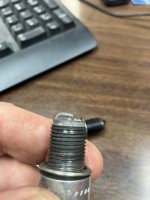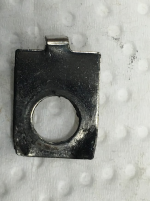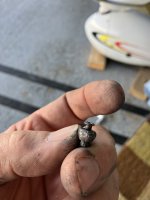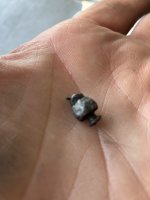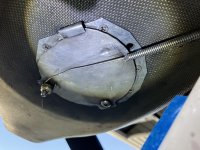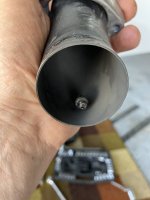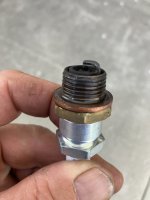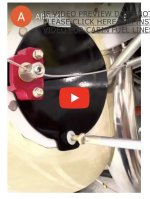I have about 400 hours on a completely rebuilt O-320-D2A that has had something crush the grounding strap closed on three different spark plugs in the last 3-4 hours.NGK-BR8ES first 2 times running with 2 Emags. This has happen on two different cylinders both the back cylinders 3 once & 4 twice, all times lower plugs in a RV9A. When rebuilt at a known shop in Colorado a new crank, cam, nitrated steel cylinders and fuel injection was installed. I put almost 300 hrs with no issues, then3-4 hours ago when flying engine stumbled then flew normal. However next flight when doing a mag check it ran bad, #3 egt dropped back when left mag was shut off. Pulled plug and found the ground strap on spark plug crushed down flat touching center electrode. Using an end scope top of piston showed carbon build up but no damage, valves looked good and compression check was good mid 70's. Put a new plug in and engine ran good for about ¾ hour when engine stumbled on climb out at neighboring airport but ran good going home but on the ground before shut down check mags and # 4 cylinder showed bad when right mag shut off. Pulled spark plug and ground strap was bent down maybe with a .004 gap. End scope showed carbon build up more oily than the first cylinder but no damage. These plugs were less than a year old with maybe 70 hours on them, originally set to .035. I called the Emag factory and they were very helpful and while not knowing what caused the damage after telling tell about the carbon buildup on the top of the piston thought it was possible a chunk came off hitting the grounding strap of the plug bending it. They recommend I try one step hotter plugs NGK-BR7ES which I changed all 8 to those. Start up and mag checks good but on the first climb out at full rich at 1000agl engine stumbled bad but after 1-2 seconds came back and ran good while I immediately made a normal landing. #4 cylinder lower sparkplug crushed down to .010. Engine was setup for Colorado at 5000 MSL where I am at 1000 msl maybe altitude makes a difference? I do get more that 50 rpm increase when going from full rich to shut down but thought that if I lean hard on ground it would not matter. I thought that idle mixture setting had nothing to do with cruse setting especially when I manually lean at altitude.
I always run lean on the ground and lean of peak at cruise but full rich while climbing. I am burning around 12-13 gal/hr while full throttle at full rich. I do have a fix pitch prop so during climb out I get only 2100-2200 for a while until leveling out. I typically fly lower power 60% or so at 2200 rpm but lean of peak. The previous owner told me he had trouble holding CHT down during breaking in the new overhaul so maybe the cylinder are glazed. I didn't think oil burn was that bad at 1qt per 20-25 hours but I have not kept good records on that. Maybe my oil ring or rings are stuck and I should try the oil control ring solvent flush to loosen them up? Maybe a oil ring has broke, and chucks are coming up and then hitting the spark plugs? Maybe as a last resort my AP/IA will have to pull the cylinders to check them out?
See pictures
In the top view of the plug you can see where something hit the grounding strap at the very end of it.
Any thoughts ?
Thanks for any help
Kevin
I always run lean on the ground and lean of peak at cruise but full rich while climbing. I am burning around 12-13 gal/hr while full throttle at full rich. I do have a fix pitch prop so during climb out I get only 2100-2200 for a while until leveling out. I typically fly lower power 60% or so at 2200 rpm but lean of peak. The previous owner told me he had trouble holding CHT down during breaking in the new overhaul so maybe the cylinder are glazed. I didn't think oil burn was that bad at 1qt per 20-25 hours but I have not kept good records on that. Maybe my oil ring or rings are stuck and I should try the oil control ring solvent flush to loosen them up? Maybe a oil ring has broke, and chucks are coming up and then hitting the spark plugs? Maybe as a last resort my AP/IA will have to pull the cylinders to check them out?
See pictures
In the top view of the plug you can see where something hit the grounding strap at the very end of it.
Any thoughts ?
Thanks for any help
Kevin



